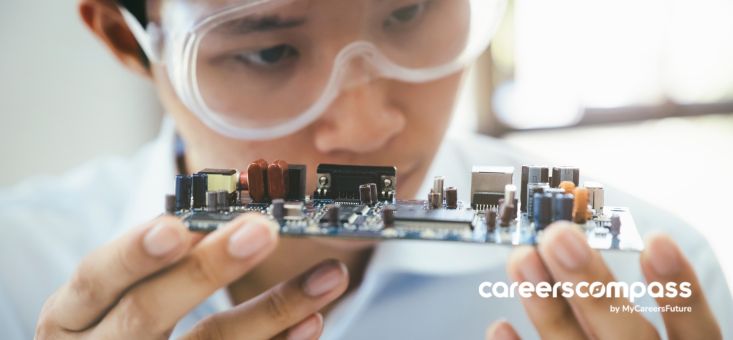About Singapore’s Manufacturing sector
By 2030, Singapore plans to boost the manufacturing sector current share of the country’s gross domestic output to S$160bn, compared to $130bn in 2023.
This was announced by Heng Swee Keat, Singapore’s Deputy Prime Minister and Coordinating Minister for Economic Policies, during the opening ceremony of Industrial Transformation Asia-Pacific (Itap) 2023.
He also shared that Singapore’s economy had managed to add 4,400 new manufacturing jobs in the first six months of 2023, which shows Singapore’s Manufacturing 2030 is making good progress.
In fact, according to the Economic Development Board, “leading firms across industrial sectors such as Micron, Infineon, and HP have set up next-generation manufacturing facilities in Singapore.”
“We are the world’s fifth largest global exporter of high-tech goods – Singapore produces four of the world’s top 10 drugs and is among the world’s top 10 exporters of machinery and equipment.”
Our ecosystem also comprises top engineering, procurement, and construction firms with facility engineering and large-scale construction expertise, and research institutes that can work directly with companies to develop cutting-edge solutions with global impact.
These initiatives have been well-received by multinational corporations (MNCs). British technology company Dyson announced plans to invest $1.5bn in its Singapore operations over the next four years, during the official opening of its new global headquarters at St James Power Station in March 2022.
“Dyson’s expansion here is possible because of the wonderful inventiveness and enthusiasm of the Singaporean engineers and scientists who have joined us,” said founder and chairman James Dyson at the event, according to reports by CNA.
“You can feel the ambition of this ingenious country. It reaffirms our belief that Singapore is the right place for high-tech, research-intensive businesses.”
He added: “Singapore is at the centre of our global supply chain. We research, design and develop products here. We have research programmes with your outstanding universities. For these reasons, it’s our global headquarters.”
It currently employs over 1,400 locally and plans to hire more than 250 engineers and scientists across areas such as robotics, machine learning and others, as well as establish a new global cybersecurity centre in Singapore.
Other manufacturers are also taking note of Singapore’s attractiveness as a hub. Aircraft engine makers Pratt and Whitney announced in early 2022 that they will be hiring another 250 full-time staff locally, in addition to the 250 new workers brought in in 2021.
The new hires will span various roles, such as engineers, technicians and production associates.
Looking to get a job in a new industry? Explore job listings on the MyCareersFuture job portal now!
Size of the job market
Tim Cormier, Pratt and Whitney’s vice-president of aftermarket operations in Asia Pacific, said to The Straits Times that the move would bring their headcount back to pre-pandemic levels by the end of 2022.
The US-based company had employed about 2,000 workers in Singapore before the Covid-19 pandemic.
Cormier said the firm’s business has picked up, thanks to strong recovery for flights within domestic markets overseas and a rise in demand for air cargo transportation.
Other aerospace firms such as GE Aviation, ST Engineering, and Rolls-Royce have also stepped up hiring locally, as the international and regional aviation and travel sectors rebounds in the aftermath of Covid-19.
Another industry moving forward from the pandemic is semiconductor manufacturing. Hit by both supply chain and manpower issues, a global chip shortage that is still dragging on since late 2020 has affected other manufacturers worldwide. The situation hurts their ability to build anything, from cars to consumer goods, and has caused prices to rise.
As such, ASM, a supplier of semiconductor process equipment, has expanded its operations in Singapore, unveiling a state-of-the-art manufacturing facility and operations hub in March 2022.
Singapore Minister for Manpower and Second Minister for Trade and Industry Dr Tan See Leng, who attended the launch, said: “Beyond boosting its manufacturing capabilities and capacity, ASM’s expansion will also advance Singapore’s semiconductor sector by creating many new jobs and business opportunities.”
The company has increased its local headcount by 250% in the last five years, and its international president and chief executive Benjamin Loh added: “Backed by strong government support, Singapore is the ideal location for our global operations, tapping into its highly educated workforce and leveraging the extensive supply chain ecosystem in the region.”
In early 2024, EDB also shared how job creation and economic value in the manufacturing sector increased, driven by a rise in such investment projects.
Manufacturing jobs in Singapore encompass roles such as:
- Test Engineers
- Process Technicians
- Control Systems Engineers
- Laser/Optics Systems Engineers
- Network Specialists
Looking for a new role? Explore over 100,000 jobs available on MyCareersFuture now!
Why is this sector important to Singapore’s economy?
DPM Heng added at Itap 2023: “Manufacturing has historically been a springboard for innovations that have been game-changers for global economic and technological advancement.
He outlined three particular kinds of innovation that the manufacturing sector should prioritise:
1. To innovate for performance
One of the key lessons from the COVID-19 pandemic is the importance of investing in efficiency and connectivity to reinforce supply chain resilience.
In an era of disruptions, rising costs and geopolitical uncertainties, becoming smarter and more connected will help the manufacturing sector reduce risks and tap on growing opportunities in new growth areas and regions, including in Asia.
In the hyperconnected world of Industry 4.0, no single manufacturing base is an island.
Rather, each country is a node, whose connection and connectivity with other nodes will shape the pace of progress, and prosperity, globally.
The ability to develop smart and interconnected value chains therefore becomes a significant competitive advantage.
2. To innovate for the planet
Today, manufacturing and production accounts for one-fifth of global carbon emissions.
The sector must do its part, to accelerate the global green transition, by working towards greater circularity, lesser and cleaner energy consumption, and reduced waste.
As a low-lying island state, Singapore is acutely vulnerable to the impact of climate change. We have therefore made sustainability an overarching priority.
The Singapore Green Plan 2030, launched in 2021, lays out a broad vision for a whole-of-society effort, including industry, to transform towards a lower-carbon footprint with improved efficiency and greater circularity.
While our own individual carbon footprint is small, the innovations that we are pioneering can serve as pathfinders to greater momentum on global climate action.
3. To innovate for Singaporean workers
To transform into Industry 4.0, the manufacturing sector must attract and retain the best talent – those with the scientific know-how but also entrepreneurial instincts, as well as an attitude of resilience and relentlessness.
Companies must therefore collectively seek to strengthen their talent pool to ensure a future-ready industrial sector.
Central to this is putting in place clear and compelling talent development pipelines and opportunities to motivate and excite young talent, in particular, to build a career in manufacturing.
Importantly, talent must be able to see the impact of their work and contributions and have a pathway for their professional development.
DPM Heng added: “In 2022, Singapore attracted a record US$16.4 bn in Fixed Asset Investments driven by exceptional inflow of large manufacturing projects in the electronics sector.”
“This is testament to the confidence that global companies have in Singapore, as a neutral and trusted venue to access global talent, capital and markets.”
“At the same time, it also reflects the view among our partners of the importance of maintaining an open global economy.”
“In the long run, countries still need to compete based on their competitive advantages.”
“A global manufacturing ecosystem that taps on the strengths of interconnected countries and regions will ultimately be more stable and prosperous.”
“This will not only create good and meaningful jobs for our people, but also support the growth of a vibrant, competitive and cutting-edge global industrial sector internationally.”
Growth areas and outlook for the manufacturing sector
As such, in Budget 2024, new support measures were announced to help Singapore become a global business innovation and talent hub for the manufacturing sector, addressing four key areas of investment and innovation promotion, energy transition, financing for growth, and workforce transformation.
Here were some of the key highlights from the Budget:
- There will be a new AI Centre of Excellence for the manufacturing sector, which will work with companies to develop relevant use cases that can benefit from artificial intelligence (AI).
- Launched in 2010, Partnerships for Capability Transformation (PACT) has been used to help defray costs borne by original equipment manufacturers (OEMs) and their suppliers — such as on equipment, materials, testing and professional services — to validate that suppliers’ procedures comply with the OEMs’ requirements. PACT also provides wage support for managers hired by OEMs to undertake supplier identification, procurement and setting up of manufacturing/quality systems.
About S$150 million has gone towards PACT since then, benefiting more than 2,500 Singapore-based firms.
PACT will be enhanced to support more collaborations between larger companies such as MNCs and Large Local Enterprises (LLEs) and Small and Medium Enterprises (SMEs).
The scheme will cover an expanded range of industry segments and modes of partnership, such as activities in capability training, internationalisation and corporate venturing, among others. - Companies will need to equip their workforce with skills for working effectively with AI-enhanced processes and systems. To this end, they can tap into the SkillsFuture Enterprise Credit that is geared toward encouraging employers to undertake enterprise and workforce transformation.
What courses or skills are needed to join the manufacturing sector?
This positive outlook is translating into a competitive job market for those in, or looking to enter, the manufacturing industry, provided they have the right skills.
In the case of the semiconductor market, a recent 2022 talent and bonus report that covers the manufacturing sector by global recruitment company Randstad reveals a recruitment landscape that favours employees and workers.
According to the report, even while other regions are struggling to meet demand in the semiconductor market, the Asian markets remain deep-rooted in a highly resilient and connected ecosystem, mainly through backend processes such as assembly, testing and packaging.
However, the global chip shortage “continues to put a tremendous amount of pressure on chip manufacturers”.
“Many manufacturing firms are expanding their workforce to clear the backlogs that were accumulated during the pandemic, as well as meet increasing demands,” Randstad revealed.
In Singapore, the industry is also facing stiff challenges in hiring, as a result of a decreasing number of science, technology, engineering, and mathematics (STEM) graduates, and many jobseekers with relevant qualifications being tempted into other industries.
Local employers are “hence more likely to offer attractive salaries and bonuses to entice talent from other companies” and will “bid to retain their workforce to meet increased workloads and address labour shortages”, the report shares.
Sustainability is a key buzzword for the industry as well, and to assist small and medium sized enterprises (SMEs) to upskill effectively for this trend, the Singapore Manufacturing Federation (SMF) unveiled the programme – known as the Chief Sustainability Officer (CSO) as a Service – on Jan 2024 in a bid to boost the competitiveness and credibility of Singapore’s export-driven manufacturing sector.
It released a playbook to help manufacturers upskill their employees, particularly in the precision engineering sector, which employs over 90,000 people.
The playbook has identified six key roles, ranging from operators to specialists and engineers. It provides details on the breakdown of essential role changes, and a strategy for specified roles to adopt new competencies and skills.
The skills include implementing automation technologies to boost productivity, using data analytics with AI and machine learning, and leveraging AI in design to enhance efficiency and reduce costs.
SMF also revealed that the playbook is the first such guide for a manufacturing sub-sector and will be one of many to cover other sub-sectors, with at least two being produced every year.
What’s the salary like in the manufacturing sector?
Jobs in the pharmaceutical and biotech sector cover a broad spectrum of roles, and salaries do vary depending on the specific job function, level of experience, and qualifications.
Here are some examples listed on the MyCareersFuture portal:
| Role | Salary Range (Monthly) |
| Manufacturing Engineer | $3,800 to $4,900 |
| Facilities Engineer | $4,000 to $5,000 |
| Quality Assurance Manager | $9,000 to $11,000 |
| Manufacturing Strategy and Performance Advisor | $30,000 to $44,000 |
| Regional Manufacturing Manager | $8,000 to $10,000 |
| Supply Chain Manager | $8,000 to $9,750 |
| Network Engineer | $4,500 to $6,500 |
| QC Laboratory Assistant | $2,500 to $3,200 |
| Buyer (Electronics Manufacturing) | $3,000 to $4,500 |
| Export Shipping Manager | $6,000 to $8,000 |
Types of jobs in the Manufacturing sector
The manufacturing sector has a wide range of jobs for various interests and skillsets, ranging from:
- Electronic Assembler
- Precision Assembler
- Warehouse Production Worker
- Engineer
- Structural Metal Fabricator
In addition, Randstad’s believes that certain roles in the manufacturing sector will be more sought-after than others in the coming years, particularly in electrical engineering, electric design, quality assurance (QA) and quality control (QC) positions.
Jobseekers or mid-career switchers who are keen on joining the manufacturing sector can get support and on-the-job training by signing up for the following Career Conversion Programmes (CCPs) for the sector by Workforce Singapore:
General Manufacturing: CCP for Manufacturing Professional
Electronics: CCP for Electronics Engineer / Assistant Engineer
Electronics: CCP for Electronics Operator
Upon successful completion of the CCPs, individuals will be equipped with the necessary skills to take on new or redesigned job roles with good career prospects within the manufacturing industry.
The CCP also integrates job-matching and training to help jobseekers join the industry, and to reskill those with the necessary competencies to take on new job roles.
Getting excited about joining the industry? Read on for more insights and information on how you can join Singapore’s manufacturing sector, and what to look forward to!

What’s it Like Working in the Biopharmaceutical Manufacturing Industry?
4 New Manufacturing Jobs to Consider in 2022
Electronics Manufacturing Jobs in Singapore: What’s the Outlook and Prospects?















